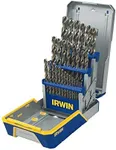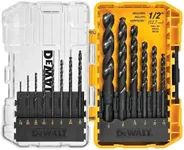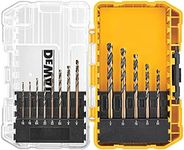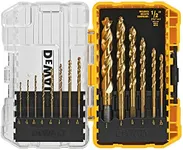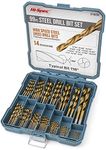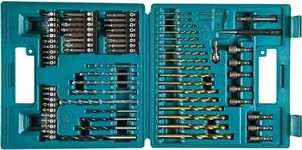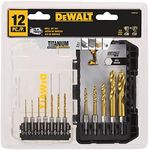Buying Guide for the Best Metal Drill Bits
Choosing the right metal drill bit can make your drilling tasks easier, safer, and more effective. The best drill bit for you depends on the type of metal you’re working with, the size of the holes you need, and how often you plan to use the bit. Understanding the key specifications will help you select a drill bit that matches your needs and ensures clean, precise holes without damaging your tools or materials.MaterialThe material of a drill bit determines its strength, durability, and suitability for different metals. Common materials include high-speed steel (HSS), cobalt, and carbide. HSS bits are versatile and good for softer metals like aluminum, while cobalt bits are tougher and handle harder metals like stainless steel. Carbide bits are extremely hard and best for heavy-duty or industrial use. To choose the right one, consider the hardness of the metal you’ll be drilling most often—softer metals can use HSS, but for harder metals, cobalt or carbide is a better choice.
CoatingDrill bit coatings, such as black oxide, titanium, or nitride, help reduce friction, increase durability, and prevent rust. Black oxide is good for general use and offers some corrosion resistance. Titanium coatings make bits last longer and are suitable for repeated drilling in harder metals. Nitride coatings provide even more durability. If you drill frequently or into tougher metals, a coated bit will last longer and perform better, while for occasional use on softer metals, an uncoated or black oxide bit may be sufficient.
Point AngleThe point angle is the angle at the tip of the drill bit, usually measured in degrees. Common angles are 118° and 135°. A 118° point is standard and works well for softer metals, providing a good balance of cutting speed and control. A 135° point is flatter and better for harder metals, as it reduces walking (slipping) and requires less force. If you mostly drill into hard metals, look for a 135° point; for general or softer metals, 118° is usually fine.
SizeDrill bits come in a wide range of diameters and lengths. The size you need depends on the diameter of the hole you want to make and the thickness of the material. Smaller bits are for pilot holes or fine work, while larger bits are for bigger holes. Make sure to match the bit size to your project’s requirements, and remember that longer bits can reach deeper but may be more prone to bending or breaking if not used carefully.
Flute DesignThe flutes are the grooves that spiral up the drill bit, helping to remove metal shavings from the hole. Standard twist flutes are common and work for most tasks, but some bits have special flute designs for faster chip removal or to reduce heat. If you’re drilling deep holes or into tough metals, a bit with wider or specially designed flutes can help prevent clogging and overheating. For most everyday tasks, standard flutes are sufficient.
Shank TypeThe shank is the part of the drill bit that fits into the drill. Common types are round, hex, and reduced shank. Round shanks are versatile and fit most drills, while hex shanks provide a better grip and are less likely to slip in the chuck. Reduced shank bits allow larger diameter bits to fit in standard drill chucks. Choose a shank type that matches your drill and the size of holes you plan to make—hex shanks are great for quick changes and high torque, while round shanks are fine for general use.



